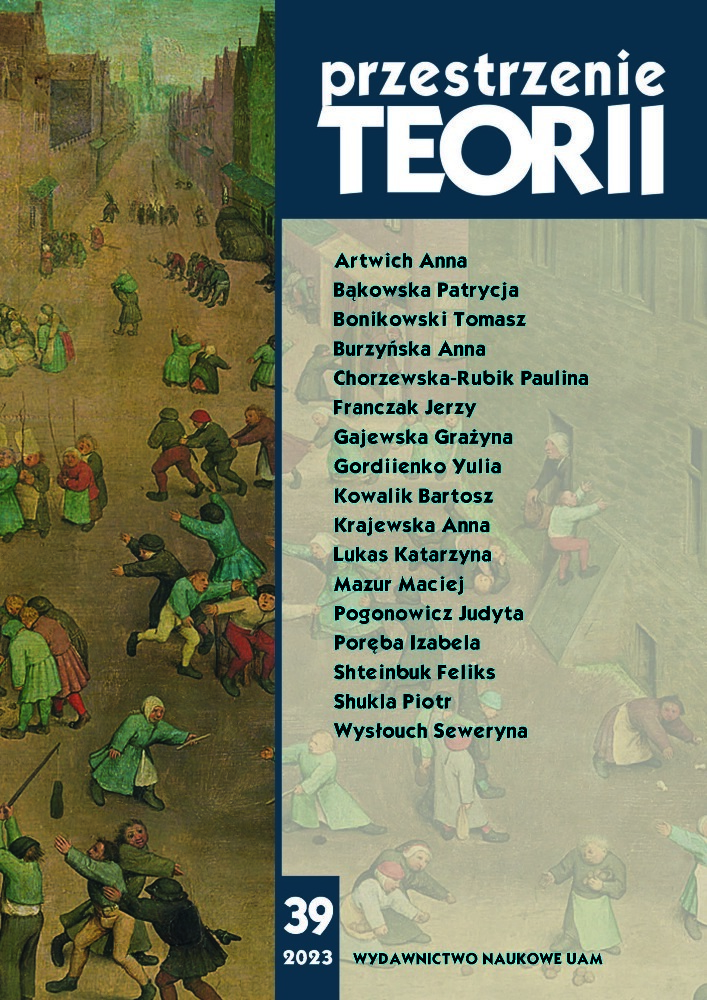Abstract
Video games are often analysed as textual objects. This default literary point of view, while providing valuable conclusions, fails to observe some essential points that are realised in different modes of narration. Here I will analyse the Cyberpunk 2077 video game from a musical perspective. I will be “listening to” the game rather than “reading” it. This kind of hermeneutical approach will highlight certain ideas of CP2077. I will focus on the issue of dehumanisation, and show that musically the game places special emphasis on this. I will point out the musical characteristics that can affect players and interpret the rationale behind it.
References
„91.9 Royal Blue Radio”, Cyberpunk Wiki, <https://cyberpunk.fandom.com/wiki/91.9_Royal_Blue_Radio.> [dostęp: 3.02.2022].
Augustyn R., Rock po roku (2), „Ruch Muzyczny” 1987, 31, nr 3, 25 stycznia, s. 22-25.
Capetola Ch., Janelle Monáe: Dirty Computer (Case Study), [w:] The Routledge Companion to Cyberpunk Culture, red. A. McFarlane, G.J. Murphy, L. Schmeink, 1 wyd., London; New York 2020, 2019, s. 245-251, [dostęp: 3.02.2022].
Collins K., Dead Channel Surfing: The Commonalities between Cyberpunk Literature and Industrial Music, „Popular Music” 2005, 24, nr 2, maj, s. 171.
Collins K., Game Sound: An Introduction to the History, Theory, and Practice of Video Game Music and Sound Design, Cambridge, Mass. 2008.
„Cyberpsychosis | Cyberpunk Wiki | Fandom”, <https://cyberpunk.fandom.com/wiki/Cyberpsychosis> [dostęp: 7.03.2022].
Fisher M., The Metaphysics of Crackle: Afrofuturism and Hauntology, „Dancecult: Journal of Electronic Dance Music Culture” 5, nr 2 (b.d.), s. 42-55.
Frelik P., Gazing (Back) in Wonder: Visual Megatext and Forgotten Ocularies of Science Fiction, „Science-Fiction Studies” 2016, 43, nr 2, s. 226-236.
Frelik P., Kultury wizualne science fiction, Kraków 2017.
Gadamer H.-G., Aktualność piękna: sztuka jako gra, symbol i święto, wyd. 1, Terminus 1, Warszawa 1993.
Gadamer H.-G., Estetyka i hermeneutyka, [w:] tegoż, Rozum, słowo, dzieje: Szkice wybrane, przeł. M. Łukasiewicz, Warszawa 2000, s. 148-159.
GDC, Immersing with Music: Approaches to Musical Storytelling in „Cyberpunk 2077”, 2022, <https://www.youtube.co/watch?v=uX9rjMZARVg> [dostęp: 7.03.2022].
Graeber D., Czy jesteś anarchist(k)ą?, Strefa zgniotu (blog), <https://blog.tranglos.com/graeber-czy-jestes-anarchistka/> [dostęp: 13.03.2022].
„Harry Harlow, Monkey Love Experiments | Simply Psychology”, <https://www.simplypsychology.org/harlow-monkey.html> [dostęp: 3.02.2022].
Ingarden R., Utwór muzyczny i sprawa jego tożsamości, Kraków 1973.
Juszczyk A., Na koncercie czy w studio? Technologiczne aspekty „żywości” muzyki popularnej, [w:] Muzyka, uniwersytet, technologia, emocje: studia nad muzyką popularną, red. A. Juszczyk, N. Giemza, K. Sierzputowski, t. 2, Kraków 2018.
Kasulis T., Japanese Philosophy, [w:] The Stanford Encyclopedia of Philosophy, red. E.N. Zalta, Summer 2019. Metaphysics Research Lab, Stanford University, 2019. <https://plato.stanford.edu/archives/sum2019/entries/japanese-philosophy/> [dostęp: 7.03.2022].
Kłosiński M., Digital Recycling: Retrotopia in Representations of Warships in World of Warships, “Game Studies” 2021, 21, nr 3, wrzesień, <http://gamestudies.org/2103/articles/klosinski> [dostęp: 7.03.2022].
Kłosiński M., Hermeneutyka gier wideo: intepretacja, immersja, utopia = Hermeneutics of video games: interpretation, immersion, utopia. Lupa obscura, Warszawa 2018.
Knapik R., Lepsze niż oryginał? Słowo o (e-)coverach, [w:] Muzyka, uniwersytet, technologia, emocje: studia nad muzyką popularną, red. K. Sierzputowski, A. Juszczyk, N. Giemza, S. Papier, t. 1, Kraków 2017.
Konik M., Muzyka u Boecjusza i w filozofii średniowiecznej, „Archiwum Historii Filozofii i Myśli Społecznej” 2006, s. 51-74.
Kotański W., W kręgu shintoizmu, t. 2, Warszawa 1995.
Kubiński P., Gry wideo: zarys poetyki, Kraków 2016.
Laudadio N.C., Music, [w:] The Routledge Companion to Cyberpunk Culture, red. A. McFarlane, G.J. Murphy, L. Schmeink, 1. wyd., London; New York 2020, 2019, s. 238-244.
Maj K.M., Światotwórstwo w fantastyce: od przedstawienia do zamieszkiwania, Kraków 2019.
Pondsmith M., Cyberpunk, the Roleplaying Game of the Dark Future: 2.0.2.0., Version 2.01, Berkley 1993.
Schmeink L., Digital Effects in Cinema, [w:] The Routledge Companion to Cyberpunk Culture, red. A. McFarlane, G.J. Murphy, L. Schmeink, 1. wyd., London; New York 2020, 2019, s. 134-143.
Sierzputowski K., Wizerunki, podmioty fraktalne, ciała spektakularne. Fenomen ciał artysty muzycznego, [w:] Muzyka, uniwersytet, technologia, emocje: studia nad muzyką popularną, red. K. Sierzputowski i in., t. 1, Kraków 2017.
Siwak W., Estetyka rocka, Warszawa 1993.
Summers T., Understanding Video Game Music, Cambridge 2016.
„User Friendly (song) | Cyberpunk Wiki | Fandom”, <https://cyberpunk.fandom.com/wiki/User_Friendly_(song)> [dostęp: 3.02.2022].
License
Copyright (c) 2023 Tomasz Bonikowski

This work is licensed under a Creative Commons Attribution-NonCommercial-NoDerivatives 4.0 International License.
Authors
Authors of texts accepted for publication in Przestrzenie Teorii are required to complete, sign and return to the editor's office the Agreement for granting a royalty-free license to works with a commitment to grant a CC sub-license.
Under the agreement, the authors of texts published in Przestrzenie Teorii grant the Adam Mickiewicz University in Poznań a non-exclusive, royalty-free license and authorize the use of Attribution-NonCommercial-NoDerivatives 4.0 International (CC BY-NC-ND 4.0) Creative Commons sub-license.
The authors retain the right to continue the free disposal of the work.
Users
Interested Internet users are entitled to use works published in Przestrzenie Teorii since 2015, for non-commercial purposes only, under the following conditions:
- attribution - obligation to provide, together with the distributed work, information about the authorship, title, source (link to the original work, DOI) and the license itself.
- no derivatives - the work must be preserved in its original form, without the author's consent it is not possible to distribute the modified work, such as translations, publications, etc.
Copyrights are reserved for all texts published before 2015.
Miscellaneous
Adam Mickiewicz University in Poznań retains the right to magazines as a whole (layout, graphic form, title, cover design, logo etc.).

